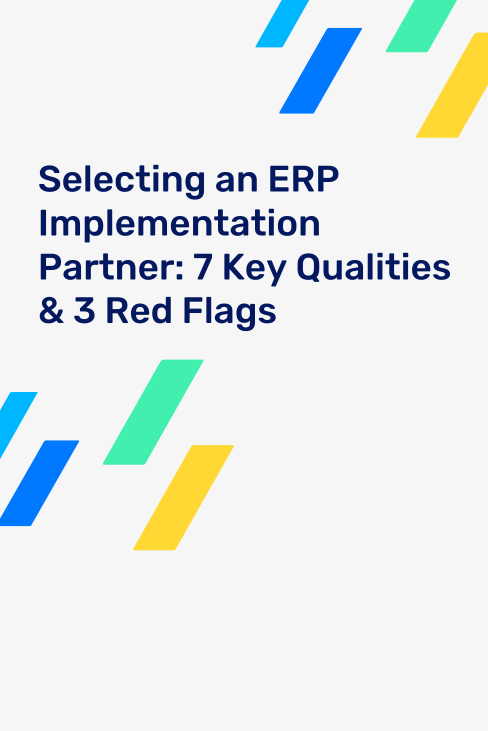Authored by Chris Rossi | Principal, Technology Advisory Services
Today’s software solutions serve as strategic tools enabling your business to achieve key financial, operational, and competitive objectives. The breadth and depth of solutions now available in the market is astounding – and while some will add efficiency and value to your business, others will prove expensive and time-consuming to set up, manage, and integrate into your day-to-day.
With mounting pressures for executives to realize ROI on technology investments, how do you select the most appropriate software for your business? After all, effective software selection is the difference between using technology successfully to advance your business or being bogged down by outdated, under-performing solutions. And, the struggle remains to get your selection right the first time, with 47% of mid-market executives declaring that planning for new technology is their greatest technology challenge.
But, here’s the good news − while selecting the right products and services can be challenging, it’s not impossible. In this post, our Technology Advisory team outlines key focus areas to consider when developing a software selection strategy that will empower your business, rather than drag it down.
1. Recognize When to Select New Software
The first step in an effective software selection strategy is to determine when it’s time to start looking for new software. If your current software is meeting all of your needs, great! But, if you’re experiencing any of the following difficulties, it’s likely time for a change:
- Difficulty onboarding employees: Outdated software can make it challenging to hire new employees. Why? Because the software is so complex or poorly documented that using it requires a great deal of institutional knowledge. Imparting this knowledge on new employees can be costly and time-consuming.
- Change management challenges: Your business is not a static entity. When you make a major change, such as opening a new line of business or adding a new location, you should consider updating your software to meet your new (and evolving) needs.
- Limited on-demand accessibility: Legacy software was not designed for today’s always-on environment. As a result, employees may not be able to work remotely or get data on the go from a mobile device. This can deprive your business of important efficiencies.
- Lacking integration: Your business should be integrated, allowing teams to easily collaborate and effortlessly share resources. This becomes impossible when the data you store on some systems are siloed, incompatible with other systems, or have to be translated manually to be moved.
- Recurring downtime: If you’re experiencing routine downtime, your software is probably the culprit. Today’s customers expect constant availability and even if you only have internal-facing applications, downtime can create crippling disruptions for your business. Many older software platforms were not designed to deliver constant uptime.
The issues described above are tricky, frustrating, and tend to manifest slowly. This often makes it easy to overlook how pervasive they are in reality. Akin to a clogged pipe, the flow slowing gradually, you don’t really notice the change when it’s happening over time. Each time you turn on the tap, the problem worsens but seems normal until the proper functionality stops. This is why you should periodically evaluate how well the software you have in place is working for your business to help proactively determine when it’s time to select new software.
2. Capitalize on Market Trends
Once you’ve decided to adopt new software, you should evaluate prevailing trends in the market to build the right software selection strategy. Today’s software market trends include:
- Migration from on-premise to the cloud: The cloud can significantly reduce the time and money that businesses have to spend setting up, managing, and backing up software, as well as the hardware that hosts it.
- APIs for easier data integration: Most modern software platforms, especially those that run in the cloud, typically come with a robust set of application programming interfaces (APIs) that allow different software packages to communicate with one another. APIs make it much less complex to build integrations and share data between different software platforms. They can also enable automated data integration and process flow across disparate systems, resulting in dramatic improvements in business efficiency.
- Simplified configuration: In older software systems, heavy customization was required to make software match business process flow. While this created software that was very tightly connected to business processes, it typically made upgrades very costly and risky because customizations needed to be tested and rewritten each time an upgrade occurs. Today, configurations can be automated or handled by software vendors rather than users. This newer approach allows businesses to mirror processes and workflows in software without the complexity of customization.
3. Get Outside Help for Software Selection
While an internal project team can lead the software selection process, bringing in outside advice and a fresh perspective can be crucial to ensuring you make informed, confident decisions. Outside assistance from a third party allows you to evaluate your current software and objectively determine whether it is sufficient for your current needs or you can genuinely benefit from selecting new software. A third party can also take the lead in the software selection process, mapping your business processes and goals and identifying which software platforms align with your objectives.
A knowledgeable and experienced technology expert will:
- Ensure that your internal project team adheres to deadlines
- Assist with software contract negotiations, which can greatly minimize the amount of time that your own employees have to invest in the complex process
- Mitigate the risk of important operations being disrupted
- Help establish an effective change management program
Software Selection: The Right Time, Information, and Plan Can Pay Dividends
Software selection requires a significant investment of time and money, so approaching it with the proper mindset is crucial to a successful outcome. When done at the right time, armed with the right information, and with the right strategic plan, new software selection can generate measurable ROI. The right software will help ensure your business is equipped with the tools needed to operate efficiently, outpace the competition, and achieve key objectives − the trifecta of technology triumph.






